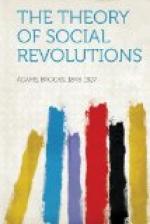The court thus simply dispensed the legislature from obedience to the law, saying in effect, “although the Constitution forbids impairing contracts, and although this is a contract which you have impaired, yet, in our discretion, we suspend the operation of the Constitution, in this instance, by calling your act an exercise of a power unknown to the framers of the Constitution.” I cannot doubt that Marshall would have flouted this theory had he lived to pass upon it, but Marshall died in 1835, and the Charles River Bridge Case, in which this question was first presented to the Supreme Court of the United States, did not come up until 1837. Then Joseph Story, who remained as the representative of Marshall’s philosophy upon the bench, vehemently protested against the latitudinarianism of Chief Justice Taney and his associates, but without producing the slightest effect.
In 1785 the Massachusetts legislature chartered the Charles River Bridge Company to build a bridge between Boston and Charlestown, authorizing it, by way of consideration, to collect tolls for forty years. In 1792 the franchise was extended to seventy years, when the bridge was to revert to the Commonwealth. In 1828 the legislature chartered the Warren Bridge Company, expressly to build a bridge parallel to and practically adjoining the Charles River Bridge, the Warren Bridge to become a free bridge after six years. The purpose, of course, was to accelerate movement by ruining the Charles River Bridge Company. The Charles River Bridge Company sought to restrain the building of the Warren Bridge as a breach of contract by the State, but failed to obtain relief in the state courts, and before the cause could be argued at Washington the Warren Bridge had become free and had destroyed the value of the Charles River Bridge, though its franchise had still twenty years to run. As Story pointed out, no one denied that the charter of the Charles River Bridge Company was a contract, and, as he insisted, it is only common sense as well as common justice and elementary law, that contracts of this character should be reasonably interpreted so far as quiet enjoyment of the consideration granted is concerned; but all this availed nothing. The gist of the opposing argument is contained in a single sentence in the opinion of the Chief Justice who spoke for the majority of the court: “The millions of property which have been invested in railroads and canals, upon lines of travel which had been before occupied by turnpike corporations, will be put in jeopardy” if this doctrine is to prevail.[21]
The effect of the adoption by the Supreme Court of the United States of the New York theory of the Police Power was to vest in the judiciary, by the use of this catch-word, an almost unparalleled prerogative. They assumed a supreme function which can only be compared to the Dispensing Power claimed by the Stuarts, or to the authority which, according to the Council of Constance, inheres in the Church, to “grant indulgences for reasonable causes.” I suppose nothing in modern judicial history has ever resembled this assumption; and yet, when we examine it, we find it to be not only the logical, but the inevitable, effect of those mechanical causes which constrain mankind to move along the lines of least resistance.




